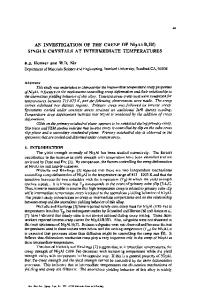Effect of oxidation on the mechanical properties of a NbAl 3 alloy at intermediate temperatures
- PDF / 3,355,034 Bytes
- 16 Pages / 576 x 792 pts Page_size
- 99 Downloads / 321 Views
M. Hebsur Sverdrup Technology, LeRC Group, Cleveland, Ohio 44135
I. E. Locci and J. Doychak NASA Lewis Research Center, MS 49-1, 21000 Brookpark Road, Cleveland, Ohio 44135 (Received 27 April 1992; accepted 18 August 1992)
Although a NbAl 3 alloy containing Cr, W, and Y has excellent oxidation resistance above 1440 K, it suffers from severe environmental attack during deformation at intermediate temperatures between 900 and 1100 K. Specimens tested in constant velocity and constant load direct compression tests showed varying degrees of degradation depending on environment (i.e., air or argon), surface finish, stress, and temperature. As a result, there were corresponding differences in mechanical behavior and in the observed microstructures. At high stresses and strain rates, specimens with as-machined surfaces were brittle at and below 1100 K when tested in air but showed fracture strains above 4% when deformed in argon. However, reproducible compressive ductility of 2 - 3 % was attained on polished specimens tested in air. At intermediate stresses, the creep curves showed sudden and periodic increases in strain before the specimens failed catastrophically after about 80 h. Microstructural examination of these specimens revealed extensive oxidation within cracks. Constant load tests conducted at lower stresses below 100 MPa showed an apparent incubation period where the change in the length of the specimen was immeasurably small. Following the incubation period, which typically lasted between 10 and 110 h depending on stress, temperature, and surface condition, specimens increased significantly in length due to oxide growth. In this case, considerable oxide spalling occurred during the course of the test, often leading to a substantial decrease in the cross-sectional area of the specimen. Microstructural observations revealed extensive cracking in the oxide layer and in the matrix, where the cracks had originated at the oxide-metal interface. The effects of environment on the mechanical properties are rationalized with the help of a schematic environmental-deformation mechanism map.
I. INTRODUCTION Advanced intermetallic alloys are presently being evaluated as potential candidate materials in aircraft engine applications for use at temperatures well above the capabilities of currently available nickel-base superalloys. In this context, the binary NbAl 3 intermetallic alloy possesses several properties that make it attractive for use as a turbine blade material. These include a relatively low density, p (p ~ 4.5 Mg m"3), a high melting point, Tm (Tm «= 1923 K), and good chemical and thermal expansion compatibility with A12O3 reinforcing fibers to enable the fabrication of light weight and high creep strength composites. However, unalloyed binary NbAl3 has poor oxidation resistance,1"7 exhibits no significant compressive ductility below 1100 K,7 and has poor low temperature fracture toughness.8 These problems coupled with the difficulty in processing this alloy have limited the use of this material in the unallo
Data Loading...











